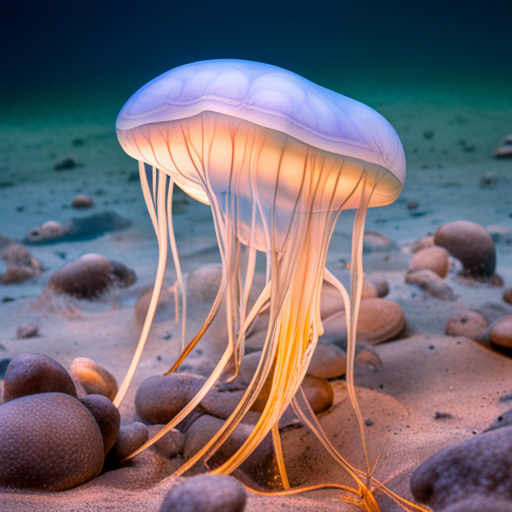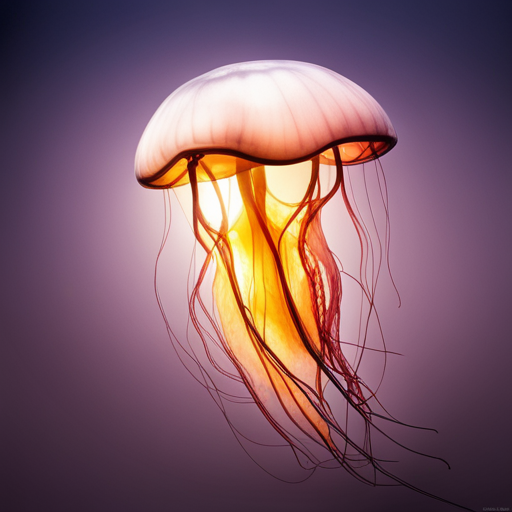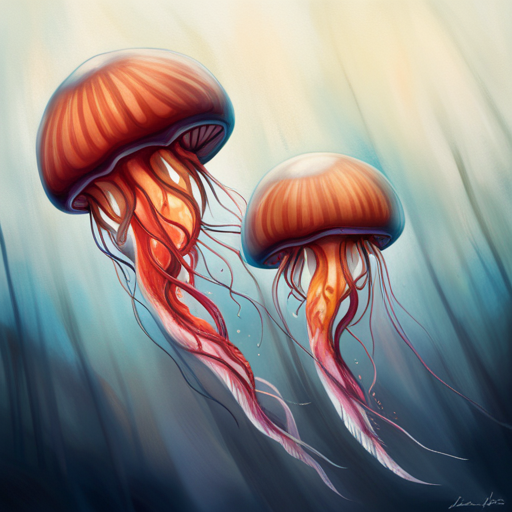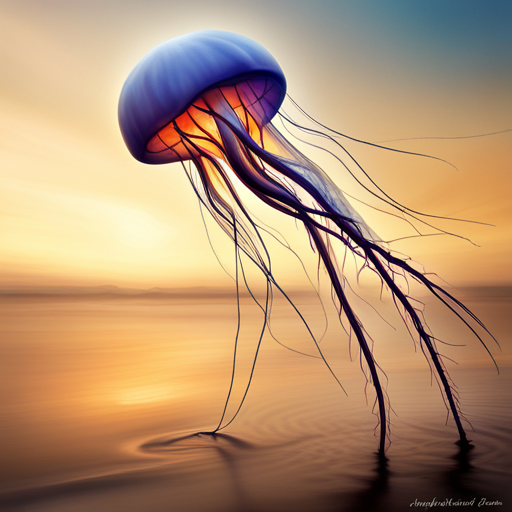You’re standing on the shore of a beautiful Australian beach, the sun warm on your skin and the sound of waves lulling you into a state of relaxation. But beneath the surface of that same water lies a creature that can kill you in minutes: the box jellyfish.
This deadly creature is both fascinating and terrifying, with its translucent, bell-shaped body and long, trailing tentacles that contain enough venom to take down a human.
The box jellyfish is like a ghost of the sea, appearing almost out of nowhere and disappearing just as quickly. Its beauty and lethality are intertwined, leaving you both mesmerized and cautious.
But there’s so much more to this creature than meets the eye, from its unique biology and mysterious behavior to the impact it has on humans and the research being done to understand it.
So, let’s take a closer look at the deadly and fascinating Australian box jellyfish and unlock the secrets of this enigmatic creature of the sea.
Overview of the Box Jellyfish

Get ready to discover the incredible characteristics of this mysterious sea creature. The Australian box jellyfish is one of the most lethal creatures in the ocean. It’s also one of the most fascinating, with its transparent bell-shaped body and long tentacles that can reach up to ten feet in length.
The box jellyfish is named after its box-like bell, which is divided into four distinct sides. This unique shape allows the jellyfish to move quickly through the water, making it one of the fastest swimmers in the ocean.
The life cycle of the box jellyfish is just as intriguing as its physical appearance. The jellyfish starts out as a tiny larva, which floats around in the ocean until it finds a suitable place to attach itself. Once it has attached itself to a surface, it begins to grow and develop into a polyp.
The polyp then produces multiple tiny jellyfish, which eventually break off and swim away to start their own life cycle. Box jellyfish prefer to live in tropical waters, and can be found in the waters surrounding Australia, the Philippines, and Thailand.
Biology and Behavior

The box jellyfish’s advanced visual system allows it to navigate its complex environment with ease, making it a formidable predator. With up to 24 eyes arranged in clusters on its bell, the box jellyfish is able to detect light, shapes, and colors, which it uses to avoid obstacles and track prey.
In fact, the box jellyfish has been observed to move at speeds of up to 4 knots, which is faster than the average human swimmer. Its unique propulsion system, which involves pulsating its bell, allows it to move through the water efficiently and gracefully.
But while the box jellyfish’s biology is fascinating, its venom is what makes it truly deadly. The jellyfish’s tentacles are covered in thousands of tiny, harpoon-like stingers called nematocysts, which inject venom into anything that comes into contact with them.
The venom of the box jellyfish is composed of a complex mixture of toxins, including neurotoxins, cardiotoxins, and skin-damaging enzymes. This potent cocktail can cause excruciating pain, paralysis, and even death in humans.
Despite its deadly reputation, the box jellyfish is an important part of the marine ecosystem, and scientists are still learning about its unique biology and behavior, including its reproduction and development.
Human Impact

You may not realize the impact that humans have on the environment, but when it comes to the box jellyfish, our actions can have severe consequences.
One of the biggest human impacts on the box jellyfish is ecotourism. Tourists flock to Australia’s northern beaches to see the beautiful marine life, including the box jellyfish. However, this leads to an increase in human activity in the water, which can lead to more jellyfish stings. Additionally, tourists may not be aware of the proper safety precautions to take when swimming in areas where box jellyfish are present, putting themselves at risk.
The impact of box jellyfish stings on humans is significant, and medical treatments are limited. The venom from a box jellyfish can cause cardiac arrest and death in minutes. Medical treatment for box jellyfish stings involves administering antivenom and providing supportive care. However, antivenom is often in short supply, and the treatment is costly. Furthermore, even with treatment, there is a risk of long-term complications, such as chronic pain and scarring.
It’s essential to raise awareness about the dangers of box jellyfish and take steps to minimize human impact on their environment to ensure their survival and protect human lives.
Research and Discovery

You’re about to dive into the exciting world of research and discovery surrounding the Australian box jellyfish! Scientific studies and findings have revealed fascinating insights into the behavior and deadly nature of these creatures.
Current research and conservation efforts are underway to better understand and protect these important members of the ocean ecosystem. Get ready to learn about the cutting-edge work being done to unravel the mysteries of the box jellyfish.
Scientific Studies and Findings
Scientists have uncovered compelling evidence regarding the behavior and physiology of this enigmatic creature, leaving you with a sense of awe and respect for the complexity of nature. Recent studies have shown that the Australian box jellyfish is not just a passive predator, but a highly intelligent and adaptable one as well.
Here are two sub-lists that delve deeper into this fascinating creature:
– Behavior:
– Box jellyfish are capable of navigating complex environments and actively seek out prey.
– They have a unique nervous system that allows them to process information quickly and respond to stimuli in a split second.
– Physiology:
– Box jellyfish have a complex venomous system that can cause severe pain, paralysis, and even death in humans.
– Recent research has shown that the venom contains a protein that can target and destroy cancer cells, making it a potential candidate for cancer treatment.
As we continue to learn more about the Australian box jellyfish, it becomes clear that marine conservation efforts are crucial in preserving the delicate balance of the world’s oceans. Venomous animals like the box jellyfish remind us of the power and complexity of nature, and the importance of respecting and protecting it.
Current Research and Conservation Efforts
Take a look at the current research and conservation efforts, as we’re delving into the truth of theories and providing visual representations of ideas. Scientists and conservationists are working tirelessly to understand the impact of the Australian box jellyfish on the marine ecosystem and how to protect it.
They have discovered that the jellyfish’s sting contains toxins that can cause heart failure and paralysis, which can be fatal to humans. As a result, they are exploring various methods to prevent the jellyfish from coming into contact with humans.
One of the primary efforts is public education. Scientists are working closely with government agencies and local communities to educate people about the dangers of the box jellyfish and how to avoid them. They are also exploring ways to develop better protective gear that will reduce the risk of stings.
Additionally, researchers are studying the chemical composition of the jellyfish’s venom to find new ways to treat victims of jellyfish stings. These conservation efforts are essential in protecting both humans and the marine ecosystem from the deadly and fascinating Australian box jellyfish.
Similar Species

If you found the Australian box jellyfish fascinating, you’ll be intrigued to know that there are other types of box jellyfish out there. Each species has their own unique characteristics, such as size, color, and venom potency.
Even though they share a similar appearance, they can differ in the number and type of tentacles they have. Exploring their differences and similarities can help us better understand these deadly creatures.
Other Types of Box Jellyfish
You may be surprised to learn that there are several other types of these stinging sea creatures aside from the infamous one found in Australia. In fact, box jellyfish can be found in oceans and coastal areas all around the world. They come in various shapes, sizes, and colors, and are named after the box-like shape of their bell. These jellyfish are known for their venomous tentacles, which can be very dangerous to humans.
Aside from the Australian box jellyfish, there are other types of box jellyfish that you should be aware of. These include the Hawaiian box jellyfish, which is found in the waters around Hawaii and can cause extremely painful stings. Another type is the sea wasp, which is found in the waters around the Indo-Pacific and is one of the most venomous creatures in the world. It has been known to cause death in humans.
These creatures have different habitat distributions, but they all have one thing in common: their stings can be deadly. So, if you plan on swimming in any of these areas, it’s important to take precautions and be aware of the potential danger.
Differences and Similarities
The different types of box jellyfish may vary in shape, size, and color, but they all have one thing in common: their venomous tentacles. The box jellyfish species found in Australia, including the deadly Chironex fleckeri, are known to be one of the most toxic creatures in the world.
However, there are some differences and similarities between the various types of box jellyfish. Here are some key differences and similarities between different types of box jellyfish to help you understand them better:
– The size of the box jellyfish can range from small to large, with some species growing up to one meter in length.
– The color of the box jellyfish can vary depending on the species, with some being transparent and others having a blue or brownish color.
– The ecological impact of box jellyfish on marine ecosystems can be significant, as they are known to consume small fish and crustaceans and can disrupt the balance of the food chain. Additionally, their venom can affect other marine life and even humans who come into contact with them.
Overall, it’s important to understand the differences and similarities between different types of box jellyfish in order to properly address their ecological impact and provide effective medical treatment for those who come into contact with them.
Cultural Significance

Exploring the significance of the Australian box jellyfish in various cultures reveals its impact on the lives of those who encounter it.
In Indigenous traditions, the jellyfish is seen as a powerful and dangerous creature that requires respect and caution. It is often associated with stories of death and tragedy, and considered a warning from the spirits to be careful in the waters.
On the other hand, the box jellyfish has also become a significant aspect of tourism in Australia. People from around the world come to experience the beauty of its habitat and the thrill of swimming with such a deadly creature. However, this fascination with the jellyfish has also led to increased danger and risk for both locals and tourists, as more and more people venture into the waters without proper knowledge and precautions.
The cultural significance of the box jellyfish is a reminder of the importance of respecting nature and understanding the impact of our actions on the environment.
Fascination and Fear

As we delve into the current section, we can feel the pulse of adrenaline and the chill of fear that comes with encountering the Australian box jellyfish. This creature is both deadly and fascinating, with its beautiful yet deadly tentacles. It’s easy to understand why people are both fascinated and frightened by it.
Exploring myths surrounding the box jellyfish is one way to understand the fear that surrounds it. People have long believed that peeing on a jellyfish sting can help alleviate the pain, but this is actually a myth. In fact, this can make the sting worse.
There are medical treatments available for those who have been stung, but the best way to avoid a sting is to stay away from these creatures altogether. The box jellyfish may be beautiful, but it’s best to admire it from a distance.
Frequently Asked Questions
How many tentacles does a box jellyfish have?
So, you wanna know how many tentacles a box jellyfish has? Well, let’s dive into the fascinating world of Box Jellyfish Anatomy.
These gelatinous creatures can have up to 60 tentacles that can grow up to 10 feet long! But it’s not just the number of tentacles that makes them deadly, it’s also their Sting Mechanism.
Each tentacle is lined with thousands of microscopic nematocysts, which are stinging cells that can inject venom into their prey. Unfortunately, humans can also fall victim to these venomous stings, which can be fatal.
That’s why Box Jellyfish Conservation and Management are so important. By understanding their anatomy and behavior, we can better protect ourselves and these intriguing creatures.
What is the lifespan of a box jellyfish?
Did you know that the box jellyfish has a relatively short lifespan? These fascinating creatures only live for about a year.
During that time, they mate and reproduce, with the females releasing thousands of eggs into the water.
Box jellyfish can be found in the waters off the coast of Australia and throughout the Indo-Pacific region, where they prefer warm, shallow waters.
Despite their short lives, these creatures are a crucial part of the ocean ecosystem. It’s important to respect their habitat and give them the space they need to thrive.
Can box jellyfish be found outside of Australia?
Did you know that box jellyfish can be found outside of Australia? The distribution of these deadly creatures is not limited to just Australian waters.
In fact, box jellyfish have been reported in various areas around the world, including the waters around Thailand, Malaysia, and the Philippines. The global impact of box jellyfish is a cause for concern, as their venom can cause heart failure and even death in humans.
With their transparent bodies and nearly invisible tentacles, box jellyfish pose a serious threat to swimmers and beachgoers in many parts of the world. It’s important to be aware of the potential danger of box jellyfish, even outside of Australia, in order to stay safe and enjoy the freedom of the ocean.
How long does it take for a box jellyfish sting to become fatal?
You’ve been stung by a box jellyfish and you’re wondering how long it will take for the venom to become fatal. The timeline of a box jellyfish sting can vary, but it typically takes around 5-20 minutes for the venom to fully take effect.
It’s important to seek medical attention immediately, as the venom can cause cardiac arrest and death within minutes. Treatment options include dousing the affected area with vinegar to neutralize the venom and seeking medical attention for pain relief and potential antivenom.
Box jellyfish venom is composed of toxins that attack the heart, nervous system, and skin cells, causing excruciating pain, paralysis, and potentially fatal reactions. Understanding the effects of box jellyfish venom on the human body is crucial in avoiding and treating a sting.
So, be cautious and stay informed about these deadly creatures.
Are there any known natural predators of the box jellyfish?
Did you know that the box jellyfish has no known natural predators? This is due to their potent venom and the fact that they are one of the top predators in their ecosystem.
The lack of predator prey dynamics for the box jellyfish has had an ecological impact on the Great Barrier Reef, where they have been known to cause significant damage to the ecosystem.
It’s fascinating to think about the impact that one species can have on an entire ecosystem, and it raises questions about the delicate balance of nature.
As humans, we also have a desire for freedom, but it’s important to recognize the impact we have on the environment around us and strive to maintain that balance for the sake of all living creatures.
Conclusion
Now that you’ve learned about the deadly and fascinating Australian box jellyfish, you might be wondering just how dangerous these creatures really are.
Well, here’s an interesting statistic to keep in mind: while box jellyfish account for only a small fraction of jellyfish stings each year, they’re responsible for the majority of jellyfish-related deaths.
But don’t let that scare you away from the ocean altogether. With proper precautions and knowledge, you can still enjoy the beauty and wonder of the sea without putting yourself at risk.
And who knows, maybe one day you’ll even contribute to the ongoing research and discovery of these intriguing creatures.
So the next time you’re swimming in Australian waters, keep an eye out for the box jellyfish and appreciate the unique role they play in our world.

